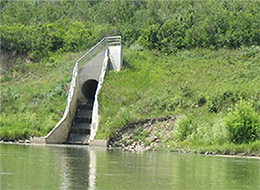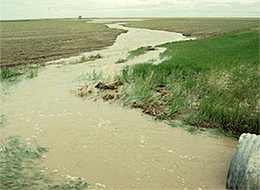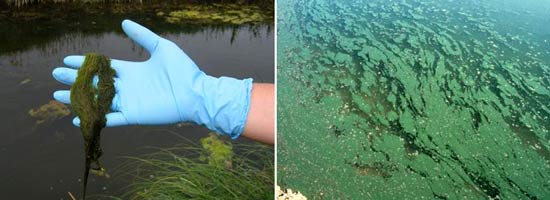The agricultural sector is by far the biggest user of freshwater. In Africa and Asia, an estimated 85-90% of all fresh water used is for agriculture. According to estimates for the year 2000, agriculture accounted for 67% of the world's total freshwater withdrawal, and 86% of its consumption. We use the water to irrigate crops and although a large percentage of the water returns from the fields, often it has been changed and is carrying soil and dissolved compounds.
While agriculture is not the only activity with the potential to affect fresh water negatively, it is a very important one. There may be surface runoff of pesticides, fertilizers and manure, or leaching of nitrogen into groundwater, the fate of which is discharge to surface water bodies. This means dissolved contaminants will eventually find their way into lakes, rivers or the ocean.
Other activities that present risks to water include manufacturing, forestry, mining, waste disposal and runoff from urban areas.
How land and water are linked
Land and water are linked together through the Hydrologic cycle.
Although the atmosphere may not be a great storehouse of water, it is the superhighway used to move water around the globe. Liquid water is changed into water vapour with 90% due to evaporation and 10% due to transpiration. This water vapour rises into the atmosphere on warm air currents. Cooler temperatures high in the atmosphere cause vapour to condense into clouds. Strong winds move the clouds around the world until the water falls as precipitation. Precipitation that falls on land completes the cycle of fresh water and results in either runoff or groundwater.
Since most water that falls on the land eventually makes its way to either a ground water or a surface water source, anything that happens on the landscape can have a big impact on the quality of the water.
Impacts to water
Runoff is simply water that is transported over the earth's surface. As it flows, it may move into the ground, evaporate into the air, be stored in lakes and reservoirs, or be extracted for agricultural or other human uses.
Infiltration is the penetration of water on the soil, or ground surface, into the ground. Once it has infiltrated, water is held as soil moisture or groundwater.
Subsurface flow is the flow of water underground, in unsaturated soil and aquifers. Subsurface water may return to the surface by way of a spring, by being pumped to the surface, or eventually seeping into the oceans. Groundwater tends to move slowly, and is replenished slowly, so it can remain in aquifers for up to thousands of years.
Since most water that falls on the land eventually makes its way to either a ground water or a surface water source, anything that happens on the landscape can have a big impact on the quality of the water.
There may be surface runoff of pesticides, fertilizers and manure, or leaching of nitrogen into groundwater, the fate of which is discharge to surface water bodies. This means dissolved contaminants will eventually find their way into lakes, rivers or the ocean. Much of the phosphorus that is moved from agricultural lands is bound to soil particles. Although it may not be a problem in this form, once deposited in fresh water sediments, there may be slow release of phosphorus in a dissolved form that can be readily taken up by aquatic plants. For this reason, the effects of deposition may be felt for many years after the source is removed or controlled. Also notice that airborne dust with adsorbed phosphorus and organic matter can travel great distances before being deposited by gravity or with precipitation.
Point and non-point sources
A fundamental distinction is made between two kinds of water contamination -point and non-point sources. A point source is one that can be located, whereas we are unable to locate the origin of a non-point source pollutant exactly. Unfortunately, this distinction is not always as simple as it sounds.

Wind erosion is a good example of non-point source additions. Some wind-eroding particles will inevitably land in water. In addition to being an important component of sediment, soil particles may also be a source of adsorbed nutrients and possibly pesticides, which dissolve after deposition.

Despite the fact that this runoff stream will discharge into a body of water at an identifiable point, sediments and nutrients are being picked up from a large area. This would be considered a non-point source. So would urban runoff, even though it usually spills into receiving waters at identifiable locations.

But a below-ground plume from a leaking gas tank which enters an aquifer that then discharges into a river would probably be considered a point source, even though contamination of the river would be over its entire area of contact with the polluted aquifer.
Sediments
Water quality problems can arise from suspended solids, which cause turbidity and form deposition of solids, called sedimentation.
Sediment that enters fresh water is usually the result of wind and water erosion from cultivated areas or stream bank erosion, which can have a variety of causes.

Turbidity refers to how clear the water is. The greater the amount of total suspended solids in the water, the murkier it appears and the higher the measured turbidity. Increased turbidity may limit the growth of bottom-rooted aquatic plants and favours the growth of algae. It can result in reduced visibility for animals that use sight to find food. Disinfection of drinking water is much less effective in waters high in particulates, because pathogens can be shielded or protected by the particles.
By blocking light penetration, large algal populations can eliminate all competition from plants rooted in the sediments. The high oxygen demand of algal mats leads to lower diversity of aquatic organisms in a water body of this sort.

Increased sedimentation also leads to infilling of reservoirs, which shortens the life expectancy of dams. Where soil erosion rates are high, costly maintenance is often required to keep irrigation ditches and canals free of sediment. Sediments may also cause clogging of waterways, producing flooding, alteration of flow patterns and the formation of new channels that may interfere with other land use activities.
Many fish species require gravelly stream bottoms for spawning. Sediments may blanket these gravel beds, interfering with normal reproduction.
Plant nutrients, particularly phosphorus, and pathogens are sometimes associated with the suspended fraction. As sediments settle, changes in chemistry occur that can promote the release of these nutrients.
Best management practices (BMPs) for erosion control
A number of BMPs have proven effective for reducing and controlling soil loss from water erosion.
Nutrients
When plant nutrients from synthetic fertilizers or organic fertilizers, decomposed crop residues, and agricultural waste products, such as wastewater from dairies, run off into fresh water, they speed up the eutrophication of water bodies. Eutrophication is the process by which lakes gradually age and become more productive. This process normally occurs over very long periods of time and its acceleration can have a range of negative impacts.
The nutrients of greatest concern are nitrogen and phosphorus. Their excessive presence can lead to increased plant biomass, usually in the form of undesirable aquatic plants and algae. As aerobic microbes decompose dead plant material, there is an increase in the demand for dissolved oxygen. The resulting oxygen depletion can cause fish kills and loss of other aquatic animal life.
Algae are most often the dominant plants in eutrophic waters. Under conditions of unchecked algae growth, mats of algae may physically block water intakes and reduce the attractiveness of water bodies for recreation. It can also create unpleasant tastes and odours in drinking water. Some species of cyanobacteria, commonly referred to as blue-green algae, produce compounds that can be toxic to livestock.
Limiting nutrients
Limiting nutrients are an important factor in the biology of fresh water. In this diagram, plant growth is represented by the amount of water in the barrel. The height of the water can't be greater than the height of the shortest stave which, in this case, is represented as nitrogen. If you add more nitrogen in this example, the barrel will be able to hold more water.

Description of the drawing above.
Drawing of barrel with staves of varying lengths to represent the different requirements of growth; the 10 staves are all labeled as follows: light, heat, mechanical support, organic matter, nitrogen, potassium, phosphorus, other nutrients, water and air. Plant growth is limited by the shortest stave- in this example Nitrogen. The barrel can only hold water to the height of the shortest stave.
In farming systems, nitrogen and phosphorus are most often the limiting factors to crop growth and are usually added in large quantities to maximize yields. In most freshwater systems, phosphorus is usually the limiting growth factor. Even small additions of phosphorus can stimulate algae and other plant growth. Nitrogen may be limiting in some streams and is usually limiting in estuaries. The migration of these important plant nutrients from agriculture to fresh water can radically upset the biological equilibrium of a water body.
Nitrogen
Some forms of nitrogen can be harmful to fish and animals.
Dissolved ammonia gas in water can be toxic to fish species. When no oxygen is present, most inorganic nitrogen is in the form of ammonia gas. This is particularly true at high pH levels.
High nitrate levels are generally not a problem in surface water where it is usually taken up rapidly by plants and algae, but it can be a concern in groundwater.
Nitrite is a reduced form of nitrogen that is usually unstable in the environment and the human body. But under certain circumstances it can be produced by the reduction of nitrates in sufficient quantities to cause illness or even death. Blue baby syndrome, or methemoglobinemia, is the best understood manifestation of nitrite toxicity. Infants under the age of one year and persons with specific gastro-intestinal disorders are particularly susceptible to high levels of nitrate in drinking water that comes from nutrient-rich wells.
High nitrate levels in water and forage can also be fatal to ruminant animals.
BMPs – Nutrient management planning
- Nutrient management planning
- Sustainable management of nutrients on the landscape for in-field livestock winter feeding systems
Pesticides
Modern agriculture relies heavily on the use of pesticides to maintain yields. It has been estimated that without pest management, pre-harvest crop losses would average 40 per cent. Unfortunately, free lunches are hard to come by and there are a number of environmental risks posed by pesticide use.
The greatest risk of pesticide use is to non-target organisms. These include species that we consider beneficial or desirable, including ourselves. Through the development of pesticide resistance and the elimination of predators due to broad-spectrum compounds, we may aid the emergence of new pest species.
BMPs – Integrated pest management
Pathogens
Pathogens is a broad term for disease-causing organisms. In water, we are generally concerned about several species of bacteria, viruses and parasites, the most common of which are listed here. Most of these are transported to water from fecal matter, either from animals or people.
Biological contamination of groundwater supplies occurs most often by contaminants entering the water by way of the well-head itself. Runoff containing manure, fertilizer, and animal remains that reaches the groundwater can contaminate the entire aquifer. This is how the municipal well in Walkerton, Ontario was contaminated.
Shallow wells are more likely to contain biological contaminants than deep wells, indicating that leaching of pathogens through coarse-textured soils is probably another pathway for disease-causing organisms to pollute groundwater. The risks associated with ingestion can be very high for rural families who rely on untreated drinking water sources.
In Alberta, 86 per cent of dugouts tested in a pilot study had coliform detections. Of those, 71 per cent exceeded Canadian Drinking Water Guidelines for total coliforms and 68 per cent had detectable levels of fecal coliforms. Interestingly, 42 per cent of farmers surveyed did not treat their dugout drinking water and 27 per cent had never had their water tested.
Organic compounds
The decomposition of organic compounds is another major source of nitrogen and phosphorus. The most common sources of organic matter loading are runoff from farmyards and cultivated fields and waste waters. Waste water may include wash waters from livestock facilities or processing facilities for agricultural products.
In addition to raising nutrient levels, organic compounds are also a carbon food source for aerobic, decomposing bacteria. Once again, increases in these bacterial populations create higher demand for the oxygen dissolved in water. As oxygen levels fall, other organisms requiring oxygen such as fish are unable to compete and populations may decline.
High levels of dissolved organic carbon and suspended organic matter also create greater challenges for water treatment systems. Organic compounds often impart unpleasant tastes and odours to water that can be difficult and costly to remove.
Hazardous chemicals
There are various other substances that can originate from agricultural operations and pose risks to water quality. Fuels such as diesel and gasoline, motor oils and other petroleum-based products such as paint thinners may contaminate fresh water when spilled or disposed of improperly. There is some potential for accumulation of heavy metals in agricultural soils that can be taken up by crops. Copper and zinc are used as animal feed additives and can accumulate in soils receiving heavy applications of manure. Cadmium and zinc from fertilizers, particularly phosphorus products, may also build up in soils.
More recently, concerns have been raised about the addition of pharmaceuticals to fresh water through runoff and wastewaters. The presence of low levels of antibiotics in water has been linked to the emergence of drug-resistant pathogens.
It has been documented that a variety of substances that are applied to agricultural fields have the potential to disrupt endocrine function in aquatic organisms. The major areas of concern are associated with pesticides and certain pharmaceuticals that have been fed to livestock and may be present in livestock manure.